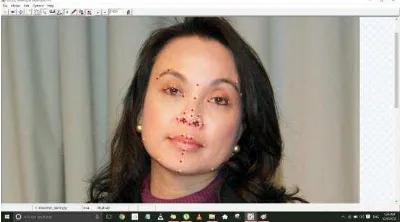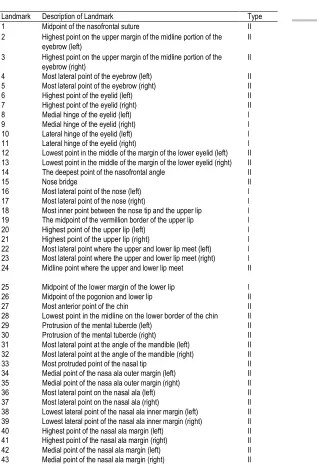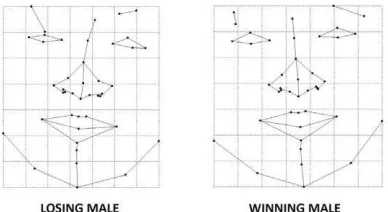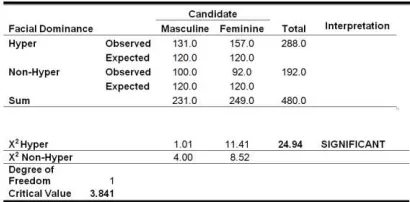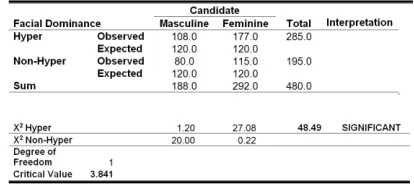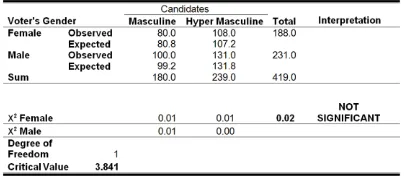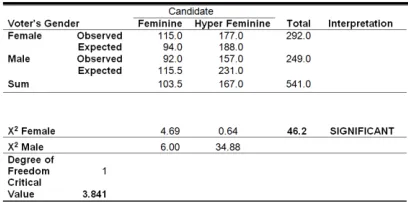http://dx.doi.org/10.18196/jgp.2016.0048.697-721
Mindanao State University- Iligan Institute of Technology, Philipine [email protected]
ABSTRAK
Menjalankan pemilihan dengan cara seperti pemilih harus diteliti dengan baik dari latar belakang dan program dari kandidat yang dipilih. Namun, dalam tidak adanya informasi lainnya, pemilih cenderung untuk menggunakan isyarat seperti persepsi mereka pada penampilannya. Penelitian ini merupakan studi perintis untuk mengadopsi penampilan morfometri dalam menguji pengaruh penampilan kandidat pada hasil pemilu sementara mereka mengabaikan kepentingan lainnya seperti jabatan, keberpihakan, dan popularitas. Hal ini juga memeriksa analisis penampilan preferensi pemilih dengan pengetahuan politik yang rendah. Penelitian ini dibagi atas 2 hal. Tahap pertama adalah analisis morfometrik penampilan dari 33 calon senator di tahun 2013 pada pemilu nasional di Filipina. Mengadopsi metode morfometrik geometrik dari ilmu alam, karakteristik dari gambar konsensus yang dihasilkan dari calon senator dianalisis dan diidentifikasi. Tahap kedua dilakukan untuk memverifikasi temuan tahap pertama penelitian melalui survei kuesioner dengan penampilan calon kandidat. Para peneliti merubah tampilan dari kontinuum maskulinitas-feminitas dan meminta preferensi tampilan responden yang dipilih. Hasil pertama yang ditemukan untuk menguatkan tahap kedua. Hal ini menunjukan bahwa citra dari 33 konsensus kandidat senat ditandai dengan maskulin hiper dan hiper morfometrio tampilan feminin. Menariknya pada tahap kedua, responden memiliki penilaian secara signifikan lebih tinggi pada calon dugaan dengan maskulin hiper dan karakteristik penampilan feminin. Hal Ini dapat diperoleh dari perilaku pemilih dari pemilih dalam masyarakat informasi politik rendah yang di isyaratkan penampilan mungkin memiliki suatu cetakan keputusan pemilihan. Oleh karena itu, hal ini sangat penting untuk mempertimbangkan dinamika pemilihan pemimpin di pemerintahan dengan mempelajari perilaku dari pemilih. Penelitian ini menandakan bahwa tampilan dari morfometrik merupakan suatu alat yang berguna dalam menentukan peluang dari memenangkan calon serta yang sebenarnya dalam pemilihan.
Kata Kunci: Morfometrik geometrik, Pemilu, pandangan Pemilih
Vol. 7 No. 4 November 2016
698
ABSTRACT
Elections operate in such manner that voters must have researched well the political backgrounds and platforms of the candidates they are voting. However, in absence of other information, voters tend to resort to cues such as their perception on facial appear- ances. This study is a pioneering study to adopt facial morphometric in testing the influ- ence of candidates‘facial appearance on their electoral outcomes while omitting other variables such as incumbency, partisanship, and popularity. It also investigates the facial preferences of voters with low political knowledge. This study is divided two-fold. The first phase is a facial morphometric analysis of 33 senatorial candidates from the 2013 Philippine national elections. Adopting the geometric morphometric method from natu- ral sciences, the facial characteristics of the generated consensus image of the senatorial candidates were analyzed and identified. The second phase was conducted to verify the findings of the first phase of the study through survey questionnaires with sets of morphed faces of presumptive candidates. The researchers morphed faces from masculinity-femi- ninity continuum and asked the facial preferences of chosen respondents. The result of the first phase was found to corroborate with the second phase. It showed that the consensus image of the 33 senatorial candidates is characterized by a hyper masculine and hyper feminine facial morphometry. Interestingly on the second phase, respondents have significantly higher votes on presumptive candidates with hyper masculine and hyper feminine facial characteristics. It can be gleaned from the voting behavior of the elector- ate in a politically low informed society that facial cues may have a bearing on moulding electoral decisions. Hence, It is highly important to consider the dynamics of electing leaders in the government by studying the behavior of the voters. This study also signifies that facial morphometric is a useful tool in determining the winning chances of the presumptive candidates as well as the actual candidates in an election.
Keywords: Geometric Morphometric, Elections, Voter’s Facial Preferences
INTRODUCTION
the influence of candidates‘ facial appearance on their electoral outcomes while omitting other variables such as incumbency, partisanship, and popularity. It also investigates the perception of voters with facial appearance as a lone basis. This study is divided two-fold. The first part is a facial morphometric analysis of 33 senatorial candidates from the 2013 national elections. The second part is a mock election conducted to determine the facial preferences of the voters. It has been identified that the findings on the facial morphometric procedure of the 2013 senatorial candidates agreed with the findings of the mock elections of pre- sumptive candidates. Geometric Morphometric is utilized in this study as a method adopted from the field of biology to analyze the facial morphometry of the senatorial candidates who ran last 2013 national elections. Lastly, this study serves as a pioneering research on the predictive value of facial appearances in explain- ing the electoral outcomes in the Philippines.
THEORETICAL FRAMEWORK
This study employs the Theory of Biological Determinism and the Theory of Good Genes Hypothesis. The “theory of biologi-
cal determinism” according to Garland Edward Allen (2015) re-
fers to the idea that all human behavior such as the tendency to choose candidates without credible basis is innate and determined by genes, brain size, or other biological attributes. This theory stands in contrast to the notion that the human behavior of making decisions based on gut-feeling and not based on facts is determined by culture or other social forces such as the set of beliefs of a person. Thus, this theory served as a guide to deter- mine whether people has an innate human behavior of making decisions specifically in choosing candidates in an election based on gut-feeling.
Good Genes Hypothesis on the other hand is anchored on the exaggeration of the faces among running politicians as the critical determinant of preference by voters. From an evolution- ary view, extremes of secondary sexual characteristics (more femi-
JOURNAL OF
GOVERNMENT &
POLITICS
Vol. 7 No. 4 November 2016
700
nine for women, more masculine for men) are proposed to be attractive because they advertise the quality of an individual in terms of heritable benefits; they indicate that the owners of such characteristics possess good genes. In other words, such traits advertise the possession of genes that are related to survival. This theory contends that the exaggerated faces among the candidates may cue attractiveness in the perception of the voters because of the quality it advertises.
RELATED STUDIES
Generally, electoral outcomes are determined by voters’ pref- erences based on the candidate’s background, party affiliation, ideologies, and charisma. However, in new democracies, candi- date appearance and electoral outcomes have had significant re- lationships too.
Institutions, ideology, and issues dominate research on vot- ing behavior in comparative politics. The conventional wisdom holds that vote choices are the result of the incentives provided by electoral rules, the identities forged by parties, the positions on the most controversial policies of the day, and the evalua- tions of incumbent performance on issues such as the economy (Lawson C., Lenz, Baker, & Myers, 2010). This study is based on a psychological research by Todorov, et al (2015) indicating that people often judge unfamiliar individuals based in their appear- ance, inferring personality traits such as competence, intelligence, honesty, and trustworthiness from facial features as basis. In some instances, this happens because some voters do not have much political information and their only mode of awareness is based on posters and campaign materials that they see in public and media sources; and the voters’ first impression is also based on the faces they see in campaign materials. Thus, this study aims to look into determining the attitudes of voters towards different facial features.
records, and party affiliation that are deemed as the fundamen- tal determinants of voter preferences. However, the scarcity of resources and the luxury of time to gather resources impede the voters from researching on these matters.
Thus, in order to validate the claim, the usage of the photos of the candidates was highly incorporated in this research since it is considered to be the first hand information if not the only information that the voters would acquire. Moreover, the amount of political knowledge of the voter respondents was also taken into account in the research to reduce other intervening vari- ables like partisanships and incumbency. The goal of this study is to determine the correlation of the facial appearance to elec- toral success using Geometric Morphometric and would apply quantitative treatment to data.
FACIAL FEATURES OF MASCULINE, FEMININE AND HYPER FACES
Dr. Marquardt (2014) defines a prototype face of a male by describing as 1) prominent-supra orbital (brow) ridges (frontal bossing) resulting in deep set appearing eyes, 2) flatter and nar- rower eyebrows, 3) slightly narrower eyes, 4) eyes less wide open, 5) slightly longer and/or wider nose 6) slightly thinner lips (espe- cially upper lip) 7) square/ angled and or larger jaws (Bashour, 2005).
Feminine facial feature is described as 1) rounder face curves, 2) eyebrows are curved and corners are sharper, 3) long lashes that curl outwards that gives the impression of a brighter eyes and the eye shape is rounder or oval in shape 4) nose is smaller and narrower 5) cheeks are longer and rounded, 6) thicker up- per lip, and the mouth is smaller 6) jaws are with rounded edges (Peters, 2013).
Hyper faces are described as the exaggerated features of the average masculine and feminine face. For women that means larger eyes, plumper lips, narrower lower jaw and smaller chin; for men, bushier eyebrows, sunken eyes and a wider, longer lower
JOURNAL OF
GOVERNMENT &
POLITICS
Vol. 7 No. 4 November 2016
702
jaw, according to Victor Johnston, a professor of biopsychology at New Mexico State University in Las Cruces (Smith, 2000).
MALE AND FEMALE FACIAL PREFERENCE
In the study conducted by Berggren et.al (2006), their study have found that female respondents tend to favour female candi- dates, while male respondents tend to vote equally often for men and women. They have confirmed that female respondents tend to vote for women to a larger extent than men tend to vote for men. They found a similar pattern in general evaluations: fe- male respondents tend to evaluate women in photos clearly more positively than male respondents do, while the sex differences in evaluating photos of men are small.
Little et al. (2007) also suggested that on average, male re- spondents perceive male candidates to be more intelligent and competent than female candidates, and female candidates to be more beautiful, likable and trustworthy. Female respondents give more positive evaluations of female candidates in all respects (Berggren et.al, 2006).
PREFERENCE ON HYPERNESS
Perrett et al. (1994) found that exaggerating the physical dif- ferences between attractive faces and average faces (i.e. creating caricatures of attractive faces) increased their attractiveness. In other words, Perrett et al. demonstrated that attractive faces are
not ‘only average’ (as some researchers who proposed the Aver-
TRAITS ATRRIBUTION TO FACIAL PREFERENCES
Recent studies by Ambady and Rosenthal (1992; 1993; 2008) have linked candidate appearance to the increase in psychologi- cal literature on the automatic processing of images of human faces. This research indicates that people often draw inferences about the character and abilities of others from their facial fea- tures, despite the fact that such inferences are of dubious accu- racy (Mueller and Mazur 1996; Zebrowitz 1997; Ambady, Bernieri, and Richeson 2000; Hassin and Trope 2000; Zebrowitz et al. 2002; Rule and Ambady 2008). Laboratory studies, in which subjects cast hypothetical ballots after seeing pictures of politi-
cians’ faces, suggest that voters employ this same heuristic when
evaluating candidates (Keating, Randall, and Kendrick 1999; Todorov et al. 2005; Johns and Shephard 2008).
While shortcuts enable citizens to make snap choices, on the flip side, it also demonstrates that these shortcuts can sometimes bias electoral outcomes and voter choice. In the absence of other information, voters may resort to cues that lead to stereotyped perceptions of candidates that hinder the electoral success of candidates. Sex and race can both lead to the attribution of ste- reotypical traits. Male candidates are perceived as tough, aggres- sive, self-confident and assertive, while their female counterparts are described as warm, compassionate, people-oriented, gentle, kind, passive, caring and sensitive (Huddy and Terkildsen 1993a, 1993b; Leeper 1991; Rosenwasser and Dean 1989). Sex and race are also used as a cue not only to infer issue positions and ideol- ogy as well with women and black candidates being seen as more liberal (McDermott 1998).
Social stereotypes create their own reality through a multistep causal mechanism: (a) Facial appearance elicits social stereotypes or expectations for the behavior and traits of attractive and unat- tractive targets, (b) these expectations are acted on by the per- ceiver in the form of differential judgments and treatment of attractive and unattractive targets, (c) differential judgment and treatment cause the development of differential behavior and
JOURNAL OF
GOVERNMENT &
POLITICS
Vol. 7 No. 4 November 2016
704
traits in attractive and unattractive targets, and (d) attractive and unattractive targets internalize differential judgment and treat- ment and eventually develop differential behavior and self-views (for detailed discussions, see Darley & Fazio, 1980; and Zebrowitz, 1997).
METHODOLOGY
RESEARCH DESIGN
This research employed qualitative and quantitative methods. Qualitative method was used to describe the facial attributes of the consensus image of the winning and losing candidates of the 2013 national elections. In the acquisition of data, the official campaign materials that are available online were downloaded. The faces of the candidates from these graphics and posters were profiled from losing and winning faces.
The first part of the study is a facial morphometric analysis on the faces of the 33 senatorial candidates. The researchers de- termined facial landmarks on the faces of the candidates. These facial landmarkings characterized the morphometric differences in the facial structures of the losing and winning candidates. The manual input of landmarks was done through TPSDig program. The TPSutil program assisted the classification of the landmarked faces by group that are set by the researchers. There are a total of 17 losing male candidates and 8 winning male can- didates and a total of 4 winning female candidates and 4 losing female candidates. The program classified this group from one another.
After the landmarkings and classification, a consensus image of male and female candidates for both winning and losing were produced through TPSrelw program. In treating the consensus images, it is qualitatively compared to the standard description of the average masculine and feminine face.
candidates. It is also used to determine the correlation of sex and facial preferences.
The researchers used survey questions for a mock election containing six sets of images. Each sets contain a masculine, hyper masculine, feminine and hyper feminine face. The images were produced through Face Morpher software. The voter respondents were asked to vote for the face they preferred the most and justify those choices by describing the image. Moreover, qualitative method was also used again to evaluate the voter respondents’ judgments on morphed faces.
LOCALE OF THE STUDY
The locale of the study is within the coastal area, rural area, and urban area of Tubod, Lanao Del Norte and Iligan City. Spe- cifically, this study was conducted in the farmlands and coastal areas of Tubod-Lala, Lanao Del Norte and employees within the Silver Lights Bakery of the same place and Barangay Tibanga, Iligan City. Lanao Del Norte including Iligan City has a total registered voters of 498, 814 in the year 2013. Its voter turn-out is only 365, 815 (Moneypolitics, 2013).
RESEARCH PARTICIPANTS
The total number of respondents is 160 with 40 participants per chosen sector. The researchers divided the total participants fairly according to sexes, which means that 80 of it are men and the other 80 are women. The primary respondents are fishfolks and farmers from Tubod, Lanao Del Norte; factory workers from Silver Lights Bakery in Tubod; and trisikad drivers from Barangay Tibanga, Iligan City.
RESEARCH INSTRUMENTS
For the facial morphometric analysis, the photos of the 33 senatorial candidates were obtained from secondary resources. The researchers used geometric morphometric softwares such as TPSDig, TPSUtil, TPSRelw in order to plot the facial landmarks
JOURNAL OF
GOVERNMENT &
POLITICS
Vol. 7 No. 4 November 2016
706
on the candidates’s facial photos and to acquire a consensus image of the winning and losing candidates.
For the mock elections, this study also used a survey ques- tionnaire contaning the morphed faces of presumptive candi- dates in order to determine the facial preferences of the voter respondents. The questionnaire is comprised of morphed faces from masculine, hyper masculine, feminine and hyper feminine faces acquired through face morphing software. Moreover, the survey questionnaire also determined the demographic back- grounds of the respondents such as age, sex and as well as the amount of political knowledge they have. The voter respondents were asked how often their exposures are to news and media in order to extract those who are low informed.
The questionnaire also determined the traits that are attrib- uted to the facial features of the winning morphed faces of pre- sumptive candidates. The voter respondents were asked to pro- vide an explanation for their preferences to identify the traits that they are looking for in a candidate.
TPSDig assisted the researchers to identify the 43 facial landmarks from the faces of the electoral candidates. The landmarks were manually inputed in the program.
FIGURE 1. LOCATION OF ANATOMICAL LANDMARKS OF THE FACE PLOTTED THROUGH TPSDIG.
TREATMENT OF DATA
morphometrics were applied to the photos of the candidates as- sisted by softwares such as TPSDig, TPSUtil and TPSRelw.
TABLE 1. ANATOMICAL LANDMARKS OF THE FACE
JOURNAL OF
GOVERNMENT &
POLITICS
707
Landmark Description of Landmark Type
1 Midpoint of the nasofrontal suture II
2 Highest point on the upper margin of the midline portion of the
eyebrow (left)
II
3
4
Highest point on the upper margin of the midline portion of the eyebrow (right)
Most lateral point of the eyebrow (left)
II
II
5 Most lateral point of the eyebrow (right) II
6 Highest point of the eyelid (left) II
12 Lowest point in the middle of the margin of the lower eyelid (left) II
13 Lowest point in the middle of the margin of the lower eyelid (right) II
14 The deepest point of the nasofrontal angle II
15 Nose bridge II
16 Most lateral point of the nose (left) I
17 Most lateral point of the nose (right) I
18 Most inner point between the nose tip and the upper lip I
19 The midpoint of the vermillion border of the upper lip I
20 Highest point of the upper lip (left) I
21 Highest point of the upper lip (right) I
22 Most lateral point where the upper and lower lip meet (left) I
23 Most lateral point where the upper and lower lip meet (right) I
24 Midline point where the upper and lower lip meet II
25 Midpoint of the lower margin of the lower lip I
26 Midpoint of the pogonion and lower lip II
27 Most anterior point of the chin II
28 Lowest point in the midline on the lower border of the chin II
29 Protrusion of the mental tubercle (left) II
30 Protrusion of the mental tubercle (right) II
31 Most lateral point at the angle of the mandible (left) II
32 Most lateral point at the angle of the mandible (right) II
33 Most protruded point of the nasal tip II
34 Medial point of the nasa ala outer margin (left) II
35 Medial point of the nasa ala outer margin (right) II
36 Most lateral point on the nasal ala (left) II
37 Most lateral point on the nasal ala (right) II
38 Lowest lateral point of the nasal ala inner margin (left) II
39 Lowest lateral point of the nasal ala inner margin (right) II
40 Highest point of the nasal ala margin (left) II
41 Highest point of the nasal ala margin (right) II
42 Medial point of the nasal ala margin (left) II
Vol. 7 No. 4 November 2016
708
TPSutil program separated the landmarked faces according to groups and categories set by the researchers. Out of the 25 male candidates, the program separated the 8 winning candi- dates from the 17 losing candidates. On the other hand, from the 8 running female candidates, the TPSutil program separated the 4 winning female candidates from the 4 losing female candi- dates.
TPSrelw was used to generate the consensus configuration of the faces of the male and female winning and losing candidates. This helped in the visualization of variation of the winning and losing candidates relative to the entire population.
In determining the preferred facial features among morphed faces of presumptive candidates, and its relationships between the sexes of the voter respondents, chi-square test is used. The Chi Square statistic compared the tallies or counts of categorical responses between two (or more) independent groups such as the male respondents and the female respondents.
In treating the qualitative data for the traits attributed to the winning facial characteristics of the morphed faces of presump- tive candidates, the gathered answers were analyzed and coded into themes. The frequency of the answer was also recorded to determine the most recurring description.
RESULTS AND DISCUSSION
FACIAL MORPHOMETRIC ANALYSIS OF THE CONSENSUS
IMAGE OF THE WINNING AND LOSING CANDIDATES OF
Figure 2 shows the consensus face of the losing and winning male politicians in the senatorial race last 2013 national elec- tions (see appendices for names). The faces of the candidates were profiled through facial landmarking. Through TPSrelw, it created a consensus image of the losing and winning male candi- dates of 2013 senatorial elections.
FIGURE 3. CONSENSUS FACE OF THE WINNING AND LOSING FEMALE CANDIDATES OF THE 2013 SENATORIAL ELECTIONS
JOURNAL OF
GOVERNMENT &
POLITICS
709
Vol. 7 No. 4 November 2016
710
more masculine trait as compared to the losing male candidates.
FIGURE 2. CONSENSUS FACE OF THE WINNING AND LOSING MALE CANDIDATES OF THE 2013 SENATORIAL ELECTIONS
Little et al. (2007) found out that facial appearance poten- tially associated with leadership is facial dominance. Facial domi- nance is better seen in more masculine features. Dominant ap- pearance is related to occupational status in certain settings. Fa- cial masculinity, linked to facial dominance (Perrett et al., 1998) and it also positively relates to testosterone level (Penton-Voak & Chen, 2004), suggesting a link to actual dominant behavior (Mazur & Booth, 1998) in dominant-faced individuals.
These studies explain why the findings of the study showed that the consensus face of the winning male candidates possessed a more masculine feature.
consensus face of the losing female candidates. Lastly, the con- sensus face of the winning female candidates is rounder than the consensus face of the losing female candidates. This com- parison shows that the consensus face of the winning female candidates fits more the description of a more feminine face. Thus, this further shows that the consensus face of the winning female candidates is more feminine than the consensus face of the losing female candidates.
Huddy and Terkildsen (!993) explains that more feminine facial characteristics are described as warm, compassionate, people-oriented, gentle, kind, passive, caring and sensitive.
Perrett et al. (1994) found out in his study that voters regard- less of sex prefer a more femininised versions of the faces. For voters, exaggerated feminine characteristics are attractive. This study by Perrett et al. (1994) support the findings of this study with more feminine features as the winning face in the consen- sus image of the 2013 female senatorial candidates.
PREFERENCE BY SEXES
TABLE 2. FACIAL PREFERENCE OF THE MALE VOTERS AMONG THE MORPHED FACES OF PRESUMPTIVE CANDIDATES
Table 2 shows that hyper feminine and feminine faces are significantly preferred by male voters than the masculine and hyper masculine candidates. Specifically, hyper feminine candi- dates are significantly preferred by male voters, followed by hyper masculine, masculine then feminine.
The yielded high results for hyper feminine face among male
JOURNAL OF
GOVERNMENT &
POLITICS
Vol. 7 No. 4 November 2016
712
voter respondents supports the findings of Perret et al. (1998) which contend that males also demonstrate very strong prefer- ences for the more femininised version of the faces. In both male and female faces, exaggerated characteristics were found attrac- tive by the respondents.
TABLE 3. FACIAL PREFERENCE OF THE FEMALE VOTERS AMONG THE MORPHED FACES OF PRESUMPTIVE CANDIDATES
Table 3 shows that female voters prefer hyper feminine and hyper feminine candidates over hyper masculine and masculine candidates. Specifically, the female voters preferred hyper femi- nine face followed by feminine, hyper masculine then masculine face.
The high number of votes for hyper feminine face in female voter respondents supports the findings that females tend to show strong preference for more femininised version of faces (Perret, et. al, 1998). Accordingly, exaggerated feminine characteristics are the most attractive compared to other facial characteristics.
on hyper feminine and feminine faces over hyper masculine and masculine faces because of their sex biases on being women.
PREFERENCE BY FACIAL CHARACTERISTICS
TABLE 4. FACIAL PREFERENCE OF MALE AND FEMALE VOTERS AMONG THE MASCULINE AND HYPER MASCULINE MORPHED FACES OF PRESUMPTIVE CANDIDATES
Table 4 shows that both the male and female voter respon- dents do not significantly prefer hyper masculine over masculine faces. There is no significant difference between masculine and hyper masculine face because it is perceived that hypermasculine faces (Gangestad & Simpson, 2000) are supported by evidence that men’s masculine traits signal both positive and negative at- tributes. Hyper masculine male faces are ascribed antisocial traits such as low warmth, low emotionality, dishonesty, low coopera- tiveness, and poor quality as a parent (Perrett et al., 1998). Hyper masculine faced men are also perceived to have more interest in short-term than long-term relationships (Kruger, 2006), and hypermasculine faces have more short-term, but not long-term, partners than average masculine men (Rhodes, Simmons, & Peters, 2005). Because human masculinity is associated with both benefits and costs, voters may vary in the extent to which they prefer hypermasculinity versus average masculinity in male faces (Little et al., 2007). This explains why hyper masculine face is not significantly preferred against masculine face.
Furthermore, this finding is consistent with those of studies demonstrating that factors that are known to influence women’s preferences for masculinity (e.g., menstrual cycle phase, for re-
JOURNAL OF
GOVERNMENT &
POLITICS
Vol. 7 No. 4 November 2016
714
views see Jones et al., 2008a and Thornhill and Gangestad, 2008)
may have a bearing on women’s preferences for different mark-
ers of men’s masculinity, similarly. For example, women show stronger preferences for masculinity during the fertile phase of the menstrual cycle than at other times when judging the attrac-
tiveness of men’s faces (Jones et al., 2005; Penton-Voak et al.,
1999; Welling et al., 2007). However, the researchers did not administer the cognizance of women’s menstrual cycle. But the effect of this factor might have affected the results of inisgnificance.
TABLE 5. FACIAL PREFERENCE OF MALE AND FEMALE VOTERS AMONG THE FEMININE AND HYPER FEMININE MORPHED FACES OF PRESUMPTIVE CANDIDATES
TABLE 6. FACIAL PREFERENCE OF MALE AND FEMALE VOTERS ON THE HYPER AND NON-HYPER MORPHED FACES OF PRESUMPTIVE CANDIDATES
strong preferences for the femininised versions of the faces. In- triguingly, both male and female participants also preferred the femininised male faces to the masculinised ones. Specifically, both male and female faces, exaggerated feminine characteristics are attractive. Moreover, another study by Rennels et al. (2008) also observed general preferences for femininity when judging the attractiveness of the faces manipulated in sexual dimorphism of 2D face shape. Further studies also found out that men typically demonstrate strong preferences for feminine characteristics in
women’s faces (Jones et al., 2007; Perrett et al., 1998; Welling et
al., 2008)
Table 6 shows that both male and female voter respondents significantly prefer hyper feminine face and hyper masculine face over the feminine and masculine faces.
The preference on the hyper masculine and hyper feminine face agrees with the findings of Perret, et.al (1994). Perrett, et al. demonstrated that attractive faces are not ‘only average’ as some researchers who proposed the Averageness Hypothesis of attrac- tiveness had suggested but that some exaggerated facial charac- teristics are attractive.
This further supports the study of Johnston (1999) that re- spondents universally preferred the faces at the more extreme ends of the spectrum. Accordingly, the characteristics found in hyper faces are the “hormone markers” that appear in puberty and distinguish the sexes. Testosterone causes boys’ lower jaws to grow long and broad; estrogen makes girls’ lips swell with fat deposits. The markers provide unconscious cues to good mating material—health and fertility.
TRAITS ATTRIBUTED TO THE FACIAL CHARACTERIS-
TICS OF THE WINNING MORPHED FACES OF PRESUMP-
TIVE CANDIDATES
The respondents were asked why they preferred the hyper masculine face. The voter respondents described the face in single word or by phrase. From the survey with the voter respondents,
JOURNAL OF
GOVERNMENT &
POLITICS
Vol. 7 No. 4 November 2016
716
the following themes or category are drawn: Physical Facial Quali- ties, Leadership Approach, People Oriented Qualities, Qualities Relating to Credibility, Moral Traits, Dominant or Aggressive Qualities, Religious/Cultural Reasons, Qualities Related to Work, Qualities Referring to Self-Conduct, Qualities Attributed to People, and Qualities Pertaining to People’s Expectation.
These traits are what the voter respondents have associated to the hyper masculine face. Presumably, these traits are also the descriptions that they look for in a political candidate. These traits are what the voter respondents have associated to the hyper feminine face. This facial attribution further reveals the charac- teristics that the people look for in a political candidate.
This finding supports the study of Zebrowitz. Accordingly, social stereotypes create their own reality through a multistep causal mechanism: (a) Facial appearance elicits social stereotypes or expectations for the behavior and traits of attractive and unat- tractive targets, (b) these expectations are acted on by the per- ceiver in the form of differential judgments and treatment of attractive and unattractive targets, (c) differential judgment and treatment cause the development of differential behavior and traits in attractive and unattractive targets, and (d) attractive and unattractive targets internalize differential judgment and treat- ment and eventually develop differential behavior and self-views (Darley & Fazio, 1980; and Zebrowitz, 1997). This means that the voters’ judgments and facial stereotypes influences their be- haviors thus, affects their decisions on their votes.
The results of the trait attributions on the faces further proved Galton’s findings on morphing methods and face averaging. Galton were able to identify multiple cues that covary with social attributions, more trustworthy when more feminine, and more dominant when more masculine. This inquiry was able to yield the same results for the face judgments on the hyper feminine and hyper masculine faces.
Male candidates are perceived as tough, aggressive, self-confident and assertive, while their female counterparts are described as warm, compassionate, people-oriented, gentle, kind, passive, car- ing and sensitive (Huddy and Terkildsen 1993a, 1993b; Leeper 1991; Rosenwasser and Dean 1989). Similarly, this study also yielded the same result on the facial attributions. Hyper mascu- line face was also similarly described as tough and assertive. On the same breadth, this study also gained the same result that hyper feminine face shows more sensitivity and caring percep- tion.
CONCLUSIONS
The facial morphometric analysis of the 33 senatorial candi- dates determined the facial characteristics of the winning and losing faces in election. The study shows that the 2013 elected senators possess facial features of a more masculine face for male candidates and more feminine face for female candidates as com- pared to the losing candidates. This also shows that the voters are likely to prefer facial appearances that are more hyper in fea- tures. Both the male and female respondents shared preference on hyper faces, specifically on hyper feminine face. The respon- dents have further associated positive traits to their facial prefer- ences.
These findings support the theory of Biological Determinism explained by Allen (2015) which states that voters are likely to vote based on gut-feeling in the absence of credible basis. The theory on Good Genes Hypothesis further proved that exagger- ated faces are more preferred by the voters when facial cues are the most available information. Moreover, this study challenged the theory of Galton on the Averageness Hypothesis of Attrac- tiveness which claimed that attractive faces are the ones that are average. In contrary, this research showed that hyper faces, in- stead of average are more preferred by the voters. This is sup- ported by the study of Perret et al (1994) that attractive faces are not average but exaggerated faces or hyper faces.
JOURNAL OF
GOVERNMENT &
POLITICS
Vol. 7 No. 4 November 2016
718
The inquiry on facial preferences of the electorate also tells a lot about the society and the level of political knowledge the elec- torate has. This study contributes in explaining the political be- havior of the electorate in times when the political knowledge is low. This signifies the need to advance the dissemination of po- litical information and to re-strategize the methods of campaigns to make the information more accessible to the electorate.
From the findings and analysis of this study, it can be inferred that facial appearance of the candidates serves as a cue in mold- ing the electoral decisions of the voters that have low political information. It further shows that the theories and methods on natural sciences such as Biology can be adopted in social sci- ences to explain certain social, political and psychological phe- nomena. While the marriage of these two very different fields can be further developed, this study effectively employed Geo- metric Morphometric as a useful tool in determining the chances of winning of the presumptive candidates and even actual candi- dates in the elections.
REFERENCES
Aharon, I., Etcoff, N., Ariely, D., Chabris, C. F., O’Connor, E., & Breiter, H. S. (2001). Beautiful Faces Have Variable Reward Value: fMRI and Behavioral Evidence. Neuron, 32, 537-551.
Ambady, (1992), Bodily Communication 92nd Edn), London; Methuen
Armstrong, J., Green, K. C., Jones Jr., R. J., & Wright, M. (2008). Predicting Elections from
Politician’s Faces. Scholarly Commons, 1-15.
Atkinson, M., Enos, R. D., & Hill, S. J. (2007). Candidate Faces and Election Outcomes. Los Angeles: Unpublished manuscript.
Avery, Robert B. Patricia E. Beeson and Pail D. Calem. (1996). Using HMDA Data as a Regulatory Screen for Fair Lending Compliance. HYPERLINK “http://www.springer.com/ new+%26+forthcoming+titles+(default)/journal/10693” Journal of Financial Ser- vices Research
Bailenson, J. N., Iyengar, S., Yee, N., & Collins, N. (2008). Facial Similarity Between Voters and Candidates Causes Influence. HYPERLINK “http://guilfordjournals.com/doi/abs/ 10.1521/jscp.1997.16.1.43” Public Opinion Quarterly, 72(5), 935-961.
Ballew II, C. C., & Todorov, A. (2007). HYPERLINK “http://www.princeton.edu/main/news/
archive/S19/28/30C37/index.xml?section=topstories” Predicting political elections
from rapid and unreflective face judgments. Proceedings of the National Academy of
Sciences, 104(46), 17948-17953.
Bashour, Mournir,(2005) Eyelid Recontructiion,Lower Eyelid. eMedicine
Berggren, N., Jordahl, H., & Poutvaara, P. (2006). HYPERLINK “http://ftp.iza.org/
dp2311.pdf” The Looks of a Winner: Beauty, Gender and Electoral Success. Helsinki
Center of Economic Research (119).
El Moliuno Milis, Edward Allen Vandercook (1976)..Began Operation. California Face Research. (2016, March 11). Introduction to Attractiveness Research. Retrieved from
Face Research: HYPERLINK “http://faceresearch.org/students/attractiveness” http:// faceresearch.org/students/attractiveness
Grammer, K., & Thornhill, R. (1994). Human (Homo sapiens) Facial Attractiveness and Sexual Selection: The Role of Symmetry and Averageness. HYPERLINK “http://
www.academia.edu/1969204/Human_Homo_sapiens_facial_attractiveness_and_- sexual_selection_the_role_of_symmetry_and_averageness” Journal of Comparative
Psychology, 108(3), 233-242.
Hamermesh, D. S., & Biddle, J. E. (1994). HYPERLINK “https://wiwi.uni-paderborn.de/ fileadmin/dep1ls6/Research/Beauty_and_the_Labor_Market_Hamermesh_Biddle.pdf”
Beauty and the labor market. American Economic Review, 84(5), 1174-1194. Hassin, R., & Trope, Y. (2000). Facing Faces: Studies on the Cognitive Aspect of Physiog-
nomy. HYPERLINK “http://www.ncbi.nlm.nih.gov/pubmed/10821193”Journal of Per-
sonality and Social Psychology, 78(5), 837-852.
International Encyclopedia of the Social Sciences. (2006). HYPERLINK “http://www.world- cat.org/title/international-encyclopedia-of-the-social-sciences/oclc/183713985” Bio-
logical Determinism. Thomson Gale.
Jones, B. C., & DeBruine, L. M. (2007). HYPERLINK “http://link.springer.com/article/10.3758/
BF03192944” The Role of Symmetry in Attraction to Average Faces. Perception and
Psychophysics, 69(8), 1273-1277.
Langlois, Judith H.; Kalakanis, Lisa; Rubenstein, Adam J.; Larson, Andrea; Hallam, Monica; Smoot, Monica;. (2000). Maxims or Myths of Beauty? A Meta-Analytic and Theoreti- cal Review. Psychological Bulletin, 126(3), 390-423.
Laustsen, L. (2014). HYPERLINK “http://politica.dk/fileadmin/politica/Dokumenter/ph.d.- afhandlinger/lasse_laustsen.pdf” Choosing the Right Candidate: How the Evolved Mind Votes in Modern Elections. Politica.
Lawson, C., Lenz, G., Baker, A., & Myers, M. (2010). HYPERLINK “http://web.mit.edu/
polisci/people/faculty/documents/Lawson%20lenz%20baker%20myers%202010.pdf”
Looking Like a Winner: Candidate Appearance and Electoral Success in New Democ- racies. World Politics, 62(4), 561-593.
Leorie Huddy, Nayda Terkildsen Am.J.Pol.Sc, (1993), HYPERLINK “https://www.jstor.org/
stable/2111526?seq=1” \l “page_scan_tab_contents” Gender stereotypes and the perception of male and female candidates. pp 119-147
Little, A. C., Burriss, R. P., Jones, B. C., & Roberts, S. (2007). HYPERLINK “http://www.eh-
bonline.org/article/S1090-5138(06)00076-6/abstract” Facial appearance affects vot-
ing decisions. Evolution and Human Behavio r, 28, 18-27.
Lopez, A. (2012, February 27). Politics, In Your Face. Retrieved from The Evolution Insti-
tute: HYPERLINK “https://evolution-institute.org/article/politics-in-your-face” https:// evolution-institute.org/article/politics-in-your-face/
Mattes, K., Spezio, M., Kim, H., Todorov, A., Adolphs, R., & Alvarez, R. (2010). HYPERLINK
“http://people.hss.caltech.edu/~rma/Election%20Outcomes%20and-
%20Trait%20Assessments_02.pdf” Predicting Election Outcomes from Positive and
Negative Trait Assessment of Candidate Images. Political Psychology, 31(1), 41-58. Mutz, D. C., Brody, R. A., & Sniderman, P. M. (1996). HYPERLINK “https://www.jstor.org/
stable/3792091?seq=1” \l “page_scan_tab_contents” Political Persuasion and Atti-
tude Change. Ann Arbor: University of Michigan Press.
Nixon, B., & Pollom, S. (2006). HYPERLINK “http://psych.hanover.edu/research/Thesis06/
JOURNAL OF
GOVERNMENT &
POLITICS
Vol. 7 No. 4 November 2016
720
NixonandPollom.pdf” Effects of Facial Maturity on Voting Preference. Unpublished
Manuscript.
Olivola, C. Y., & Todorov, A. (2010). Elected in 100 milliseconds: Appearance-Based Trait Inferences and Voting. HYPERLINK “http://www.fundraisingresearch.info/
USERIMAGES/olivolatodorov.pdf” J Nonverbal Behavior, 34, 83-110.
Perret, D. I., May, K. A., & Yoshikawa, S. (1994). HYPERLINK “http://www.nature.com/
nature/journal/v368/n6468/abs/368239a0.html” Facial shape and judgements of fe- male attractiveness. Nature, 368, 239-242.
Poutvaara, P., Jordahl, H., & Berggren, N. (2009). Face of Politicians: Babyfacedness pre-dicts inferred competence but not electoral success. HYPERLINK “https://
www.researchgate.net/publication/222825748_Faces_of_Politicians_Baby -
facedness_Predicts_Inferred_Competence_but_Not_Electoral_Success”Journal of
Experimental Social Psychology, 45(5), 1132-1135.
Quezon III, M. L. (2015, October 5). The Great Referendum: The National Election of
2016. Retrieved from Inquirer: HYPERLINK “http://opinion.inquirer.net/89706/the-
great-referendum-the-national-election-of-2016” http://opinion.inquirer.net/89706/ the-great-referendum-the-national-election-of-2016
Rosen, D. (2013, October 21). Face Off: How First Impressions Decide Elections. Re-
trieved from Campaign and Elections: HYPERLINK “http://www.campaign- andelections.com/magazine/1732/face-off-first-impressions-decide-elections” http:/ /www.campaignandelections.com/magazine/1732/face-off-first-impressions-decide- elections.
Smith R, Red Smit. (2000). HYPERLINK “http://www.publishersweekly.com/978-1-56663- 289-8” On Baseball The Game’s Greatest Writer On The Game’s Greatest Years. Ivan R Dee Publishers
Spezio, M., Loesch, L., Gosselin, F., Mattes, K., & Alvarez, R. (2012). HYPERLINK “http:// onlinelibrary.wiley.com/doi/10.1111/j.1467-9221.2012.00897.x/abstract” Thin-Slice Decisions Do Not Need Faces to be Predictive of Election Outcomes. Political Psychol-
ogy, 33(3), 331-341.
Todorov, A., Olivola, C. Y., Dotsch, R., & Mende-Siedlecki, P. (2015). Social Attributions from Faces: Determinants, Consequences, Accuracy, and Functional Significance.
Annual Review of Psychology, 66, 15.1-15.27.
Thornhill, (2000), The Clinical Examination.Baltimore. Fourth Edition
White, A., Kenrick, D. T., & Neuberg, S. L. (2013). HYPERLINK “http://www.annualreviews.- org/eprint/EIiV7qBNKRKA2uTieC5T/full/10.1146/annurev-psych-113011-143831” Beauty at the Ballot Box: Disease Threats Predict Preferences for Physically Attractive Leaders. Psyhcological Science, 1-8.
Zebrowitz, L. A., & Montepare, J. M. (2005). HYPERLINK “http://science.sciencemag.org/
content/308/5728/1565” PSYCHOLOGY: Appearance DOES Matter. Science, 308(5728), 1565-1566.
Zebrowitz, L. A., Hall, J. A., Murphy, N. A., & Rhodes, G. (2002). HYPERLINK “http://
